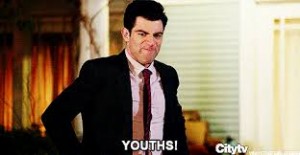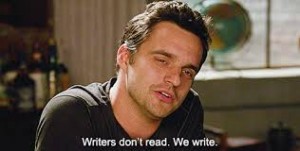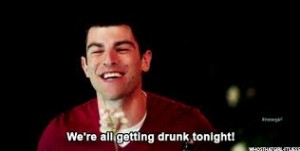October 9, 2014
As an entrepreneurial journalist, there are several ways to go about pitching your idea…and the hit TV sitcom, New Girl, can help you plan the perfect pitch.
The first approach when thinking about a pitch is to identify a small pain that needs to be solved.
The next thing to do is investigate existing solutions and focus on little ideas. For example, New Girl’s Schmidt suggests to start with youths and younger generations. But Jess suggests food.
Be sure to illustrate the impact of your idea with lots of multimedia. This will help get your point across more clearly and it will keep the attention of the audience.
Make the most of spontaneous pitch opportunities! Be sure to keep it fresh–keep up with change and innovation. And always be prepared.
Oh, and don’t listen to Nick Miller. Always read and be up to date on current events and trends.
When your pitch has finally been successful, be sure to reward yourself BUT keep up the hard work!
October 2, 2014
In a competitive landscape and journalism market, strategizing is a key tool in becoming successful. In Entrepreneurial Journalism, Briggs states that forming a personal productivity strategy begins with an equation…
What you need to manage plus the right tools you need to manage it.
You also need to remember that your market strategy begins and ends with your audience.
One key point is to assess your competitors and comparables. Briggs says, “It’s possible to learn from others’ successes and failures with out becoming preoccuppied by the fear that they will steal your business.” If you simply review and analyze the strengths and weaknesses of your competition, this could help to chart your course.
Briggs says that you should contact your competition. Instead of being sneaky, you can position yourself as someone who would like to “talk shop”. This would help to provide more knowledge about your market and what has worked and not worked.
Another point Briggs makes is to identify your value proposition. Competing for news coverage can have you tempted to match every one of your competitors articles and can be bad for your well-being. Being aware of your competitors is an asset, but your main goal is to focus on the strengths and value of your work. You should always ask yourself; who, what, when, where, and why when defining and analyzing your value as an entrepreneurial journalist.
For example, the website for Organic Olivia is one that I am on daily. I feel that this site is a perfect show for identifying its value. Organic Olivia has found a niche that inspires her as a whole and her site. She shares recipes, facts and information about GMOs and food, beauty and detoxing, and even sells e-books, healing jewelry and shares her story with the world.
Organic Olivia’s website has a lot of value but the main one being that she simply shares her story of how her knowledge about GMOs and organically-grown food have changed her life. She documents it in pictures; from showing how overweight she was to how fit and healthy she has become.
This site is a motivator for people trying to learn more about the processed food exposure in America and one that found its place on the web.
While acknowledging and following through with your strategies, one should also review their opportunities.
In, How entrepreneurial journalists can identify opportunities by Poynter, it makes a point that one should start by investigating existing solutions. Poynter states that, “The existence of other solutions to a problem you’ve identified can be useful evidence that the problem is real. The key question is whether there are components of the problem that remain to be addressed, or if the solution you have in mind would fill an important gap.”
So the main question to ask yourself is, would people want to pay for your solution?
September 25, 2014
Sonia Nazario’s website for the book, Enrique’s Journey, not only sheds light on one boy’s journey to America to find his mother, but it casts a spotlight on the plight of undocumented immigrant children as a whole in the United States. The web site is not just publicity for Nazario’s book; she shares background information on where immigrant children migrate from as well as pictures of the harsh reality these children face as well as people who help them along the way. Nazario also lists past and upcoming events about where she will be available to help educate people about these children immigrants and lists resources that people should discuss as well as sharing the KIND (Kids in Need of Defense) nonprofit organization that recruits pro bono attorneys to represent these unaccompanied immigrant children during their court time. Nazario also shares updates about Enrique’s family and how they are doing.
Although most of the pictures on this website are compelling, the one I was drawn most to was the one that was labeled, “Tránsito Encarnación Martínes Hernández, from Honduras, lost part of both legs to a train,”under the pictures of injured migrants. This picture showed the rawness and the true difficulty and trouble that these kids go through just to make it to America. They sit on top of these freight trains and risk their lives just to have a chance to make it to the land of the free.
After looking at the Enrique’s Journey website, Unaccompanied migrant children in the United States: Research roundup from Journalist’s Resource, and Unaccompanied Children Released to Sponsors By State from the U.S Department of Health and Human Services, I thought of a way you could localize the unaccompanied minor story.
The U.S. Department of Health and Human Services provides state-by-state data of accompanied children released to sponsors. After seeing that New Jersey is home to 2,171 immigrant children, the department of health and human services also offers a link to click that takes you to the counties these children flee too. Since I live in Essex County, I am able to see that 277 children immigrated to this county and can conduct research to localize my story.
After doing further research, I found that these immigrant children are transferred to the care and custody of the Office of Refugee Resettlement (ORR), in which they provide shelter, food, and medical care for these children until they are able to be released to sponsors. The Essex County ORR office, the Essex County Division of Welfare Military Park Citizen Services Center is located in Newark, New Jersey on Rector Street and can be reached to learn about the care of these children as well as sponsoring these children.
By obtaining this information, you can find a local immigrant child and follow his/her story.
September 18, 2014
Since the internet is at its all-time high for usage and information retrieval, learning how to create your own site can be key, especially if you are an aspiring journalist. If you haven’t created your own website before it can be extremely tough, but in Entrepreneurial Journalism, Briggs lays out essential tips that can help.
Thinking and acting are two of the simplest, yet most effective things you can do when launching your own website. If you think of your plan and put it into action, the worst thing that can happen is that you have to try it again.
Briggs tells us that growing a blog into a business is a place where every aspiring site owner can start. Blogs are an easy way for you to become active on the internet. If you set your own goals, you will be able to envision how big or small you’d like your business to become and you can measure your success.
If you find your niche and run with it whole-heartedly while producing quality content, you can build a loyal audience and turn it into a community that can add value through engaging and sharing. Finding your focus can help you practice ethical and serious journalism with good values.
All of this takes patience, so testing, trying, playing, failing and trying again is the best thing you can do. Every day, new tactics and technology are being thrown out into the world so aim big, find your focus and know that failing first is okay.
I chose to look at Buzzfeed to represent Briggs points. Jonah Peretti started Buzzfeed as an experimental lab that focused on tracking viral content. With its knack for sharing, Buzzfeed has hit over 150 million monthly visitors.
Once you can successfully become a digital journalist after thinking and acting on your dreams, picking up a few characteristics from a working Forbes journalist can help further your career.
Relating and engaging with the audience, knowing how to use the tools of social media, producing your own content such as photos, videos, podcasts, etc., and trusting in Google to give them the best chance at reaching the world all portray a certain style of a person; a resourceful one.
While being a resourceful journalist is key in surviving within this modern, digital age, keeping your values and ethics in check can be a challenge. The tension between traditional journalism and online journalism is a big challenge we face today. The culture of traditional journalism, with its values of accuracy, pre-publication verification, balance, impartiality, and gate-keeping, rubs up against the culture of online journalism which emphasizes immediacy, transparency, partiality, non-professional journalists and post-publication correction.
Sometimes, when people look at online sites, the stumble across ones such as The Onion, as well as other satire websites. This is an example of the difference between online journalism and traditional journalism where the internet has more freedom to publish and post, especially with tactics like blogs, and some things are perceived as the truth when in reality, it can be a hoax.
With traditional journalism, we question where it is going in today’s world. Will it survive? Obviously the verification and accuracy on traditional journalism is admired but it is slowly dying out to instant news.
September 11, 2014
The web has played a major part in changing our world and view of technology for the past 25 years. In the article, “The Web at 25” in the U.S. from Pew Research Internet Project, I found various interesting points to show the impact the internet has had.
Most internet users think online communication has strengthened their relationships and the majority report the environment is kind. 67% of internet users say their online communication with family and friends has generally strengthened those relationships, while 18% say it generally weakens those relationships.
- By a 76%-15% margin, internet users said the internet has been good for society and another 8% volunteered the answer that they believe it had been both good and bad. (part 2)
- In 1995, 42% of U.S. adults had never heard of the internet and an additional 21% were vague on the concept—they knew it had something to do with computers and that was about it. Now, eight in ten U.S. adults (81%) say they use laptop and desktop computers somewhere in their lives—at home, work, school, or someplace else.I feel that this could be an interesting story idea—an article about the difference of computer usage from 1995 compared to today in 2014. I feel as though studies could not only make this article effective but the use of particular facts from today’s society. For example, the use of internet on smartphones and tablets as well as in the classrooms and for homework, etc. (part 1)
9/11 Impact
This article from NBC news is titled, ISIS Threat: Fear of Terror Attack Soars to 9/11 High and written by Mark Murray. A lot of the news surrounding the 9/11 anniversary that is occurring tomorrow is highly focused on recent news about the ISIS terrorist group and conspiring attacks. This article is basically a list of percentages and studies about how American citizens no longer feel safe.
“The exclusive poll reveals that 47% of Americans believe the country is less safe now than before the Sept. 11, 2001, terrorist attacks. That’s a significant increase from even a year after the twin towers fell when in September 2002 just 20% of the country said the nation was less safe. The level of fear across America also is up substantially from last year when 28% felt the same way.”
News surrounding 9/11 isn’t about mourning the loss of loved ones and a great monument of our country, but is rather focused on other possible threat situations, conspiracy theories, etc….and it is because of the internet that conspiracies are formed and predictions are made. Photos from 9/11 are looked at and examined and people do research about plane impact and fires, trying to make sense of the catastrophe.










Danielle, I really liked your column. You had a lot of great information about the impact of the Internet on the American public and how they generally feel it is a positive, according to the report by the Pew Research Internet Project. I also liked how you talked about news coverage on 9/11 today, and how it focuses more on possible threats and how Americans no longer feel safe, than mourning those who were lost that day.
I liked the way you localized the story to the county you live in and supplied the link as well. What I would like to see is what KIND stands for, you did that with ORR but not KIND. I would also mention that she posts upcoming events towards the end of the column, that way people would remember that in case they were interested in seeing her speak or helping out with the cause. Also, attribute the Enrique’s Journey website into your column that way people can see the picture and what you are talking about.